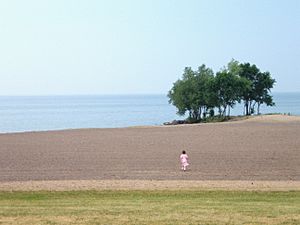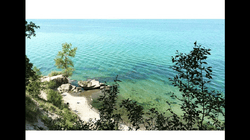Hamlin Beach State Park facts for kids
Quick facts for kids Hamlin Beach State Park |
|
|---|---|

View of the beach at Hamlin Beach State Park.
|
|
| Lua error in Module:Location_map at line 420: attempt to index field 'wikibase' (a nil value). | |
| Type | State park |
| Location | 1 Hamlin Beach Blvd. West Hamlin, New York |
| Nearest city | Hamlin, New York |
| Area | 1,287 acres (5.21 km2) |
| Created | 1938 |
| Operated by | New York State Office of Parks, Recreation and Historic Preservation |
| Visitors | 278,098 (in 2014) |
| Open | All year |
| Website | Hamlin Beach State Park |
Hamlin Beach State Park is a large park covering about 1,287 acres (5.21 km2) along the shore of Lake Ontario. It is located in the Town of Hamlin in Monroe County, New York. The Lake Ontario State Parkway goes right through the park, making it easy to visit.
History of Hamlin Beach State Park
Hamlin Beach first became a park in 1929. At that time, Monroe County bought about 597 acres (2.42 km2) of land for it. The park was first called Northwest Beach Park. It included the former Charles Wolf property and nearby farmland. Its name was changed to Hamlin Beach Park in 1930.
How the Civilian Conservation Corps Helped Build the Park
When the park was owned by the county, a special camp was built there. This camp was for the Civilian Conservation Corps, or CCC. The CCC was a program during the Great Depression. Young men worked on projects to improve parks and public lands. From 1935 to 1941, CCC workers stayed at the camp. They worked hard to make the park better. They built many facilities that are still used today.
Hamlin Beach During World War II
During World War II, the park site was used differently. It became a camp for German prisoners of war (POWs). These POWs stayed there from 1944 to 1946. The camp helped local farms and food factories. The prisoners worked there to support the war effort. After the war ended, the camp was taken down.
Becoming a State Park and Growing Bigger
In 1938, the park became part of New York State. It was then renamed Hamlin Beach State Park. After World War II, the Lake Ontario State Parkway was extended. This made it much easier for people to get to the park. The parking lot was made bigger for more visitors. New campgrounds were also built for people to stay overnight.
You can still see the work done by the Civilian Conservation Corps. They built stone walls, barriers, and picnic shelters. They also created six buildings and turned swampy land into useful park areas.
Protecting the Beach from Storms
In the 1970s, the park's beach faced a big problem. Strong storms caused a lot of erosion, washing away the sand. The state and federal governments provided money to fix this. The beaches were rebuilt, and special structures called jetties were added. Jetties help protect the shore from waves and erosion. Also, work began on the Yanty Creek Nature Trail. This trail is now about a mile long and has signs to teach visitors about nature.
Discovering the CCC/POW Camp History
In 2008, volunteers started clearing land where the old CCC/POW camp used to be. This area is off Moscow Road in Hamlin. In 2014, a special trail was opened there. This trail helps explain the history of the camp to visitors.
What to Do at Hamlin Beach State Park
Hamlin Beach State Park offers many fun activities for everyone. You can enjoy the beach, have picnics, or play at the playground. There are also special recreation programs. You can explore nature trails, go surfing, or enjoy hiking and biking. Fishing is a popular activity here too. The park has a large campground with 264 sites for tents and trailers. In winter, you can go ice skating, cross-country skiing, or snowmobiling. There's also a boat launch and a place to buy food.
Park Hours and Rules
The park is open all year round. You can swim at the beach from mid-June through Labor Day. Campsites are open from early May until Columbus Day. Sometimes, the beach might close if there's too much pollution.
There are three large parking lots that can hold 2,500 cars. There is a small parking fee for vehicles. The park is accessible for people with disabilities. You can bring your pets if they are on a leash no longer than six feet (1.8 m). Pets must also have proof of their shots before entering the camping area. However, no animals are allowed on the beach itself.
If you have a boat, you can launch it from two spots. There's a hand launch north of the Area 1 parking lot. You can also use a car-top launch on the eastern end of the beach, near the Yantee Creek parking area.
In 2016, Governor Cuomo announced a big improvement plan for the park. Hamlin Beach State Park received $2.25 million for this program. The old sandstone bathhouse, built in 1939 by the Civilian Conservation Corps, was completely updated. New bathrooms were also installed in the campground's loops A and B.
Exploring the Trails at Hamlin Beach
The Yanty Creek Nature Trail is on the eastern side of the park. You can find the start of the trail from the main park road. There's parking for about 10 cars. The trail is made of stone or mulch and goes in a loop. Along the way, you'll find signs that teach you about nature.
The Shoreline Trail is a paved path that runs along the lake. It goes from east to west, passing by the beaches. There are also other smaller trails within the campgrounds and wooded areas.
Discovering Devil's Nose
Devil's Nose is a small dirt bluff on the westernmost part of the park. This tree-covered bluff is part of a larger sand and clay area. This area extends about one mile (1.6 km) under the lake. The part of Devil's Nose that is above water used to be much bigger. But rising lake levels and erosion have made it much smaller.
In 2018, work began to reopen the trails to the public. Mulch was laid down, fences were put up, and the trails were reopened in 2019. You will see "Stay Back" signs often because there is a drop of over 200 feet.
Devil's Nose has been the site of many shipwrecks over the years. Some of these include the York in December 1799, the C. Reeve on November 22, 1862, the Almira on June 8, 1863, and the John Weeden on October 27, 1869.


